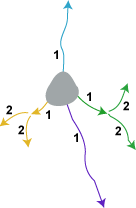Each tree (branched structure analysis)

Breaks down the results for each tree by centrifugal branch order. All segments of a given branch order for a given tree are grouped together.
Example: If a specific tree (a dendrite or axon) has 3 segments that are third-order branches, these 3 segments will be totaled and averaged in the results. See Branch Order Characteristics for details about the various types of branch order classifications.
Go to Preferences in the File menu and select Ordering to select different branch ordering methods.
Analysis results
Total length for all branches in the tree with the same branch order.
- Mean = [Length] / [Number of branches]
- Variance: Set to 0 if there is only 1 branch. Otherwise computed for the set of branches.
Computed by modeling each branch as a frustum (truncated right circular cone).
- Mean = [Surface] / [Number of branches]
- Variance: Set to 0 if there is only 1 branch. Otherwise computed for the set of branches.
Computed by modeling each branch as a frustum (truncated right circular cone).
- Mean = [Volume] / [Number of branches]
- Variance: Set to 0 if there is only 1 branch. Otherwise computed for the set of branches.
The nodes are computed according to the number of segments of that order ending in nodes and the degree of the node.
A node is assigned to the segment leading to the node.
Degrees (0, 1, 2, >2):
- Termination: degree 0.
- Bifurcation: degree 2.
- Nodes of degree higher than 2 are grouped under >2.
Quantities are computed according to their type: normal (N), high (H), low (L), incomplete (I), origin (O), midpoint (M), and generated (G).
The types were selected while tracing in Neurolucida.
| Normal Ending (N) | Default |
| High Ending (H) |
Ending located at the top of the current section. Depending on the orientation of the sections, the process may continue into another section.
|
| Low Ending (L) | Ending located at the bottom of the current section. |
| Incomplete (I) | Use to label arbitrary endings, endings that disappear for unknown reasons, endings that should be audited later. |
| Origin Ending (O) |
Indicates the directionality of the tree.
Neurolucida Explorer keeps track of directionality to apply branch orders. |
| Midpoint (M) | Ending of a long branch that is indeterminate at the time it is placed. |
| Generated (G) | When Neurolucida (or Neurolucida 360) is unable to determine an ending type, it assigns a "Generated" ending. This can happen during editing when the ending type originally assigned is no longer valid, or a new ending is created. Examples include editing to relocate the origin ending, which leaves the original origin unassigned, or splitting a branch, which creates new endings. You may need to evaluate the generated endings and assign the appropriate ending type. |
Also see Individual Tree analysis.
